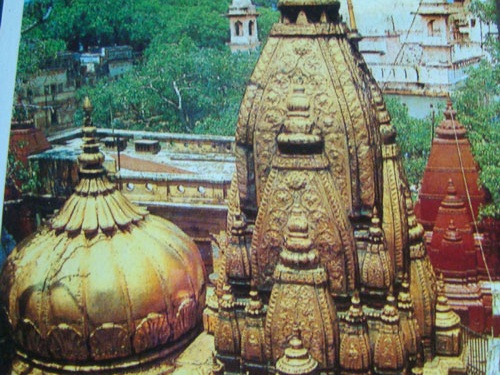
Old Kashi Vishwanath Temple
Sri Kashi Vishwanath Temple Varanasi
Some locations in the world simply attracted you as a traveler and make an enduring impression on your soul. Kashi, commonly known as Varanasi or Banaras, is one of these holy locations. The holy city of Varanasi offers many beautiful places to the visitors. From the beauty of the Ghats to the spirituality of the temples people have a lot of things to discover.
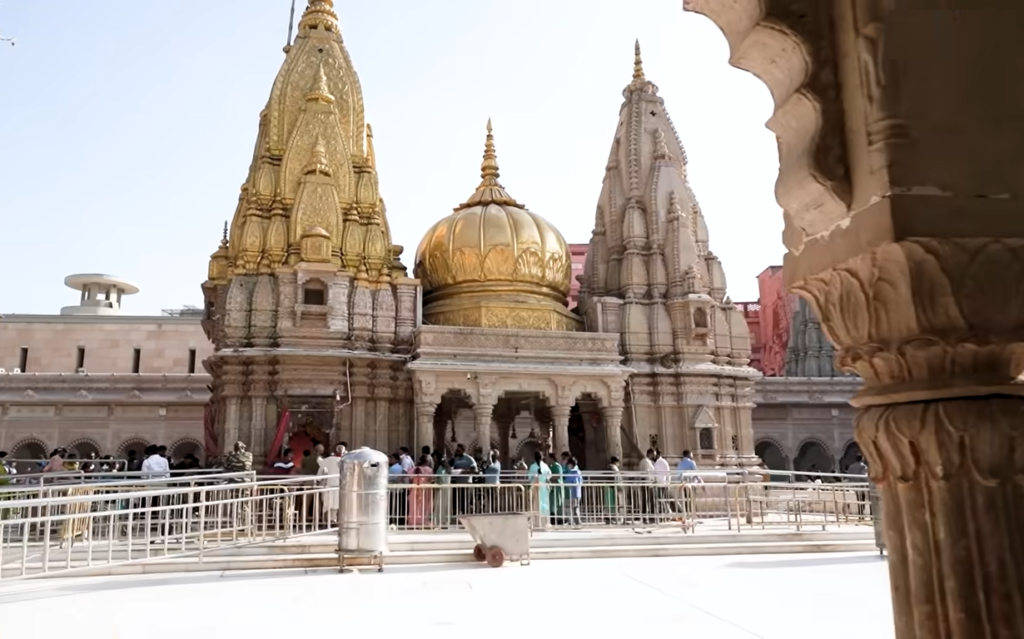
Among all, the place that attracts visitors to the incredible city of Varanasi is “Kashi Vishwanath Temple”. The major god of this temple is known as Vishwanath or Vishveshvara, which means “Ruler of the World”. Because the city of Varanasi is also known as Kashi, the temple is commonly referred to as the Kashi Vishwanath Temple. According to Hindu belief, visiting the Kashi Vishwanath Temple and bathing in the Ganges River are significant steps on the way to freedom, or moksha. Thus, devotees from all over the country make an effort to visit Varanasi at least once in their lifetime.
Awe Inspiring Architecture of Kashi Vishwanath Temple
The temple’s magnificent carvings and architecture is a pleasure to the eyes. The Kashi Vishwanath Temple is a glorious example of magnificent architecture. It is an awe-inspiring sight in the holy city of Varanasi. The Vishwanatha Galli is a narrow street that runs alongside the river and is home to a number of smaller temples that make up the larger temple complex. The main temple is in the shape of a square, and there are smaller shrines of other gods all around it. The major deity’s linga is covered with a silver altar and measures 60 centimeters (24 inch) in height and 90 centimeters (35 inch) in circumference.
The Mandir’s structure is divided into three sections. The first one is a spire on the building. The second is a golden dome, and the third is a golden tower with a flag and trident at the top. Small temples devoted to the god Kala Bhairava, Shiva, Kartikeya, Avimukteshwara, Ganesha, Vishnu, Shani, and Parvati can be found throughout the complex. The temple is home to a small well, known as the Jnana Vapi or the Gyan Vapi (the well of knowledge). Those who are lucky enough to visit Kashi Vishwanath Temple should make the most of their time there and reflect on the spiritual journey it represents.
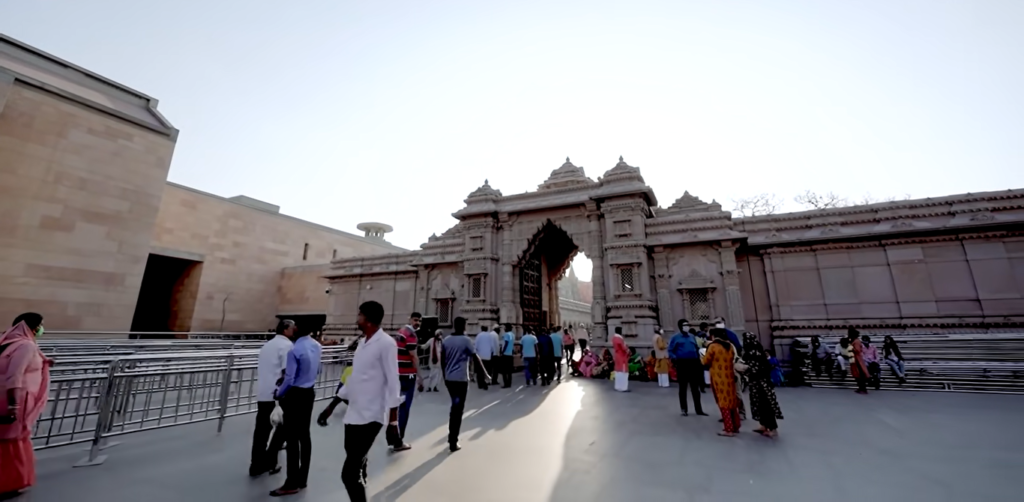
Religious Significance of the Kashi Vishwanath Temple
The temple is one of the twelve Jyotirlingas, the holiest places on Earth where Shiva is worshiped. The temple’s past begins with a story from legend. Lord Brahma and Lord Vishnu got into a fight over who was the most powerful. As a judge, Lord Shiva took the form of a beam of light that went through three worlds. Shiva told them to find the root of the light. Whoever found the light’s tip would be seen as the most powerful. Lord Brahma rode up on a horse to find the tip, while Vishnu took the form of a pig and dug down to find it. The 12 jyotirlingas are where Shiva’s light went through the earth, and this temple is one of them. A visit to this temple is a genuinely spiritual experience that should not be missed by anyone visiting Varanasi.
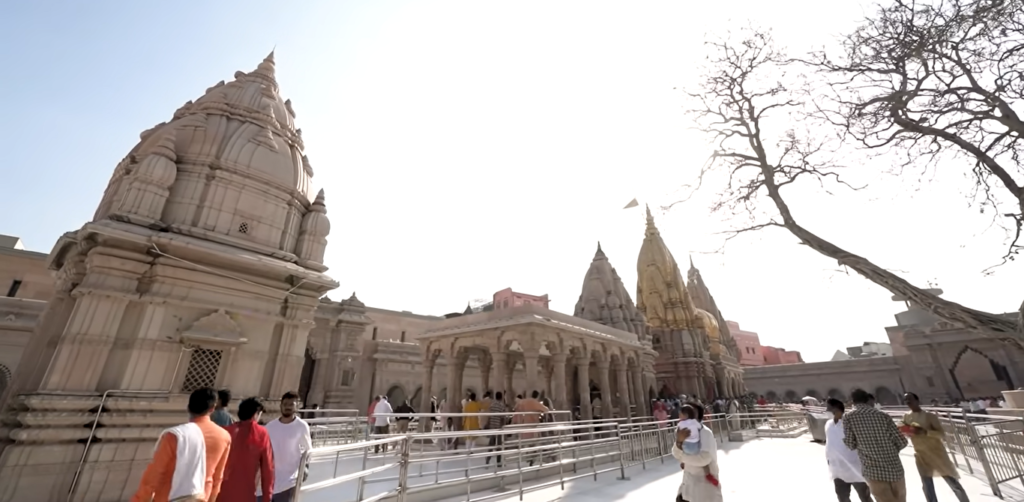
Exploring the Rich History of the Kashi Vishwanath Temple
Vikramaditya constructed a magnificent Shiva temple on the site of the current Gyanvapi Mosque. Over the centuries, the temple had been destroyed multiple times by Muslim kings, most recently by Aurangzeb, who used the site to build the Gyanvapi Mosque. It is claimed that various Indian rulers have reconstructed the Kashi Vishwanath Temple since then.
In 1780, the Maratha queen Maharani Ahilyabai Holkar of Indore supervised the construction of the current temple. In 1835, the Sikh Maharaja Ranjit Singh gave one tonne of gold to plate the temple’s dome at the insistence of his wife, Maharani Datar Kaur. Nagpur’s Raghuji Bhonsle III gave the silver to the temple in 1841. In February 2022, an unidentified donor from South India gave the temple 60 kg of gold, which was used to cover the sacred area in gold.
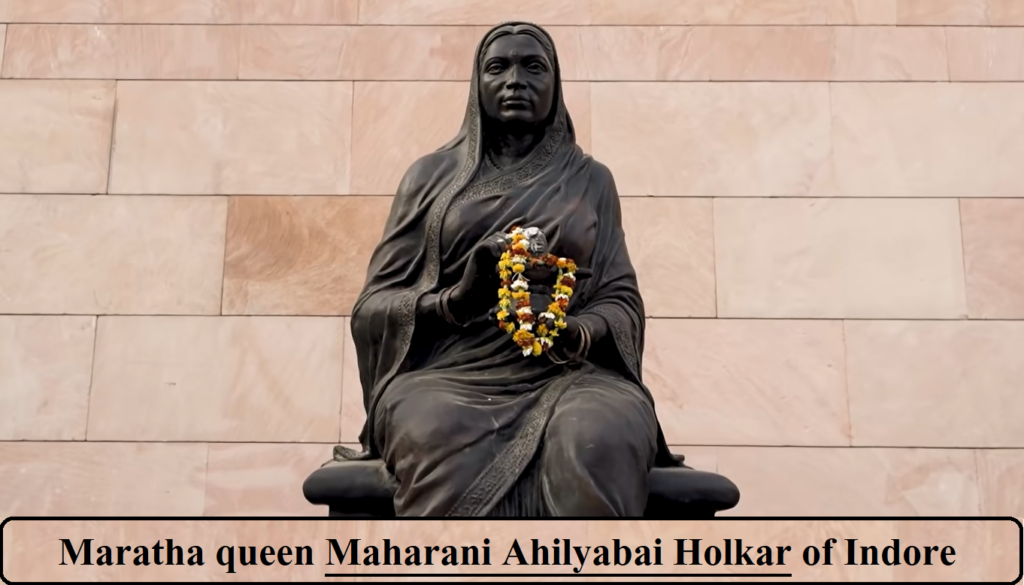
The Incredible Kashi Vishwanath Corridor
In 2019, PM Narendra Modi initiated the Kashi Vishwanath Corridor Project to widen the area between the temple and the Ganges River in an effort to ease overcrowding. Now, the crowded streets have been turned into wide pathways to help people get around. It linked the old temple to Ganga’s bathing steps. Under the project, the temple now has four entrances for the ease of the devotees. The temple is on the western side of the Ganga River. A total of 23 structures, including a museum, a viewing room, a food court, and a tourist information center are part of the project. During the work on the Kashi Vishwanath Corridor project, more than 40 old buildings were found again. On 13 December 2021, Modi opened the corridor with a holy ceremony.
Mysteries of Kashi Vishwanath Temple
One of the oldest places in the world is Kashi. Kashi is named as moksha nagri in the Rig Veda because those who die here are said to instantly attain salvation. Kashi Khanda (section) of Skanda Purana (fourth-fifth century) refers to the Kashi Vishwanath temple. The holy jyotirlinga at Varanasi was visited by many great saints, including Adi Shankaracharya, Swami Dayananda Saraswati, Swami Vivekananda, Goswami Tulsidas, Ramakrishna Paramhansa, and Guru Nanak.
Also known as the ‘Golden Temple’, it is one of the twelve holy Jyotirlinga or homes of Lord Shiva. There are about three thousand daily visits to the Kashi Vishwanath temple. On occasion, the numbers hit 1,000,000 and even higher. It is said that worshiping at the Kashi Vishwanath Temple can strengthen your connection to Lord Shiva.
Magnificent View of Kashi Vishwanath Temple
Upon entering the temple, one is immediately taken aback by its stunning design. Seeing such a vast area so beautifully decorated with incredible works of art is quite breathtaking. The surrounding mood is one of devotion and reverence, with the sound of bells and chanting creating an aura of spirituality and peace.
The view from Varanasi’s Kashi Vishwanath temple is truly breathtaking. As you get closer, the sun and the holy Ganges river make the temple look enchanting. The temple’s majestic dome stands out against the clear blue sky, and the historic city below is laid out before you like a painting. The domes of the temple are a sight to behold from afar. Offerings are offered and prayers are said to the deities, filling the air inside the temple with a sense of reverence and calm. It’s easy to feel touched by this grand building and the sight. This is an experience that can’t be matched by anything else, and the view is nothing short of breathtaking.
Shri Kashi Vishwanath Live Darshan
Kashi Vishwanath Temple ticket price
You do not have to pay anything to get into the premises. It’s free, but you have to stand in a long line and get pushed around. If you want to take part in activities under your name, you need to buy tickets. People often buy flowers for the god at the shops near the temple. However, it is not compulsory to buy flowers. You don’t have to give money to the priest or put money in the donation box. On a normal day, it takes at least two to three hours to visit the Kashi Vishwanath temple. But, if you go on Monday or other special day it could take more hours than usual.
Offered Prayers and Rituals at Kashi Vishwanath Temple
Devotees can offer prayer and perform rituals at the Kashi Vishwanath Temple. But for this devotees have to pay fees accordingly. The timing and fee of different rituals are mentioned below.
Mangla Aarti
Being the first aarti of the day, Mangla aarti holds a special significance. Every morning at around 3:00 or 4:00, the Aarti is performed. The temple is open to worshippers from 2:30 AM to 3 AM. It is during the “Brahma muhurta” that the aarti is performed. At the temple’s main entrance, you’ll need to show your ticket to enter; however free entry is allowed for Children less than 12 years. However, the scheduled Darshan time cannot be altered. The cost of attending Mangla Aarti is 500 Indian Rupees (INR).
Mid-Day Bhog Aarti
The Bhog Aarti ceremony takes place at the Kashi Vishwanath Temple every day at noon. The Aarti is conducted daily at 11:15 a.m. to 12:20 p.m. However, devotees should get to the temple at least half an hour before the Aarti begins (at 10:45 a.m.). After the Mangla Aarti, this is the next one. The Bhog Aarti is the ritual of giving thanks to the Lord for the provision of food. Prasad is the food that is shared among all the worshippers present after an offering has been made. Attending the Midday Bhog Aarti costs devotees INR 300.
Sapt Rishi Aarti
More than 750 years have passed since the rite known as the Sapta Rishi Aarti was first performed. The Aarti is concurrently performed by seven Shastris/Pandits, each of whom is from a different Gotra. Every night between 7:00 and 8:15 PM, the Aarti is recited. The suggested time of arrival for devotees to the temple before the Aarti is 6:30 p.m. However, on the day of Purnima, sapt rishi Aarti will begin early, at least an hour before the actual time. People think that the Saptarishis, who are the seven great sages, come every evening to perform Aarti to the god. Because of this, this puja is done every evening at 7 pm. The cost of attending Sapt Rishi Aarti is INR 300.
Shringaar / Bhog Aarti
Shringar Bhog Aarti is an evening ritual held at the Kashi Vishwanath Temple. After the Sapt Rishi Aarti, this is the fourth Aarti of the day. Every day from 9:15 to 10:15 PM, the Aarti is recited. The suggested time of arrival for devotees at the temple prior to the Aarti is 8:30 PM. Shringar Bhog Aarti is a prayer of thanksgiving to the Lord, who provides us with a living. Prasad is the food that is shared among all the worshippers present after an offering has been made.
Rudrabhishek
Lord Shiva is also known by the name Rudra. During this puja, the Shivling is given a holy wash with various materials, such as Panchamrit or fruit soaked in honey, and the holy chant of Sri Rudram from the Yajur Veda is chanted. The hours of Rudrabhishek are from 4 am to 6 pm. The cost is adjusted based on the total number of Shastri.
Sugam Darshan
This is an exclusive procedure for a quick, easy, and stress-free darshan visit. This costs 300 rupees. It’s intended for devoted individuals who are too busy or who have special needs (such as divyangs) to can’t wait in line. The devotee is accompanied by a Shastri and given special Prasad after receiving direct darshan without waiting in line. Sugam darshan is prohibited during aarti and on other important days. Sugam darshan can be scheduled only within the devotee’s allotted darshan time for the day. There is no way to make bookings by phone.
How to Reach this Glorious Kashi Vishwanath Temple?
If you want to experience the beauty of Kashi Vishwanath Temple, you can visit the temple easily through all the means of transportation. Nearby, there are dharmshalas, paid guest rooms, and other hotels and lodges. The Shri Kashi Vishwanath Temple Trust also runs a guest house.
By Roadways: Autorickshaws or taxis can take you to the temple along Vishwanath Gali, a famous street in Varanasi with shops selling sweets, puja items, clothes, and fashion jewelry. If you want to take a bus, the Chaudhary Charan Singh bus stand is 3 km away and the closest one to the temple.
By Airways: The Lal Bahadur Shastri International Airport in Babatpur is the closest airport to the temple. The temple is about 25 km away, which is less than an hour by car. Take a trip to the Varanasi airport and then a taxi or bus to get to the temple.
By Railways: Trains run to the city from every big city and metro area in the country. The city of Varanasi is easy to get to by train, and the temple is close to a number of railway stations. The temple is about 6 km from Varanasi Junction. The station that is the farthest away is Pandit Deen Dayal Upadhayay Junction, which is 17 km away. Banaras station is about 4 km away from the temple. Most of these stops are easy to get to from India’s biggest cities. From the train stations, you can reach Vishwanath Gali by any type of road travel.
Kashi Vishwanath Temple: Facts for the Visitors
- It is thought that Kashi was the first place where the light fell when the earth was made.
- The shrines here are built in the Nagara style, with spires that meet at the top.
- The government of Uttar Pradesh is now in charge of the Kashi Vishwanath Temple.
- People who can’t go to the temple physically to see the Jyotirlinga can view it live online.
- In the 1860s, the Rana of Nepal gave the stone figure of Nandi Bull to the temple.
- There are a lot of hotels in Varanasi close to the temple, so you can book one there to make it easier to get there.
- You can’t take a cigarette, a lighter, alcohol, a belt made of metal, or any kind of weapon into the temple.
- Inside the temple, there is always a crowd so be careful with your things and your kids.
- No matter what faith you practice, you can’t touch the god.
Quick Facts
Old structure built in: 1780
Creator: Maharani Ahilyabai Holkar
Opening time of the temple is: 3:00 am
Aarti time:
Mangala Aarti : 3 AM- 4 AM (Morning)
Bhog Aarti : 11.15 AM to 12.20 PM (Day)
Sandhya Aarti : 7 PM to 8.15 PM (Evening)
Shringar Aarti : 9 PM to 10.15 PM (Night)
Shayan Aarti : 10.30 PM – 11 PM (Night)
Distance from Temple to Railway Stations:
Varanasi Junction: 6 Km
Mughalsarai Junction: 17 Km
Banaras Railway Station: 4 Km
Varanasi City Railway Station: 2 Km
FAQs on Kashi Vishwanath Temple
Ans. At the Kashi Vishwanath temple, the cost of a VIP Darshan ticket is 300 rupees for each individual.
Ans. Sugam darshan is an early darshan procedure to avoid the huge crowd. It was made for followers who don’t have time to wait in queue or who have divyangs or other disabilities that make it hard for them to do so.
Ans. Kashi Vishwanath Mandir is one of the most revered pilgrimage destinations and one of the twelve Jyotirlinga, which are believed to be Shiva’s holiest abodes.
Ans.The original Kashi Vishwanath temple is situated in Vishwanath Gali, which is in the city of Varanasi in the state of Uttar Pradesh. The replica of Kashi Vishwanath temple stands in the campus of BHU.
Ans. The Karnataka government initiates the Kashi Yatra Scheme. Under the programme, people who want to go on a trip to Varanasi will be given 5,000.
Ans. To touch the lingam, men visitors will be required to wear a dhoti. Women devotees will only be permitted to touch the Deity if they are dressed in a sari. Devotees dressed in trousers, shirts, jeans or suits will only be able to see the deity.
Ans. VIP break Darshan is the fastest way of darshan. When regular people buy VIP Darshan tickets, they can go to the same parts of the temple as the VIPs.
Ans. Although, the temple remain crowded the whole day but going in the early morning will save you from the long queues.
Ans. No, there is no ticket for Kashi Vishwanath temple but if you want a hassle-free darshan or perform any ritual, you will need to buy tickets.
Ans. Prime Minister NarendraModi started the Bharat Gaurav Tourist Train from Bengaluru. The State Government decided that each person who booked a ticket would get a special deal of 5,000. Each person’s ticket costs 20,000. So, the whole trip will cost 15,000 Rs per person. In its 8-day trip, the train stops at the important religious sites of Varanasi, Ayodhya, and Prayagraj.
Ans. There are several stories associated with Lord Shiva’s presence in Kashi. After getting married, God Shiva and Devi Parvati wanted to live in the “Land of Siddhas.” So, they decided to come to Kashi.
Ans. Kashi is the oldest name of the city which is today known as Varanasi.
Ans. The best time to explore Varanasi is from November to February, which is in winter. Even though winters are pretty cold, this is the best time to visit the holy city without getting too tired.
Ans. Yes, one can wear jeans or clothes of their choice in Varanasi.
Ans. Mobile phones, cameras, belts with metal clips, shoes, Gutka, cigarettes, and lighters are not allowed on the temple premises.
